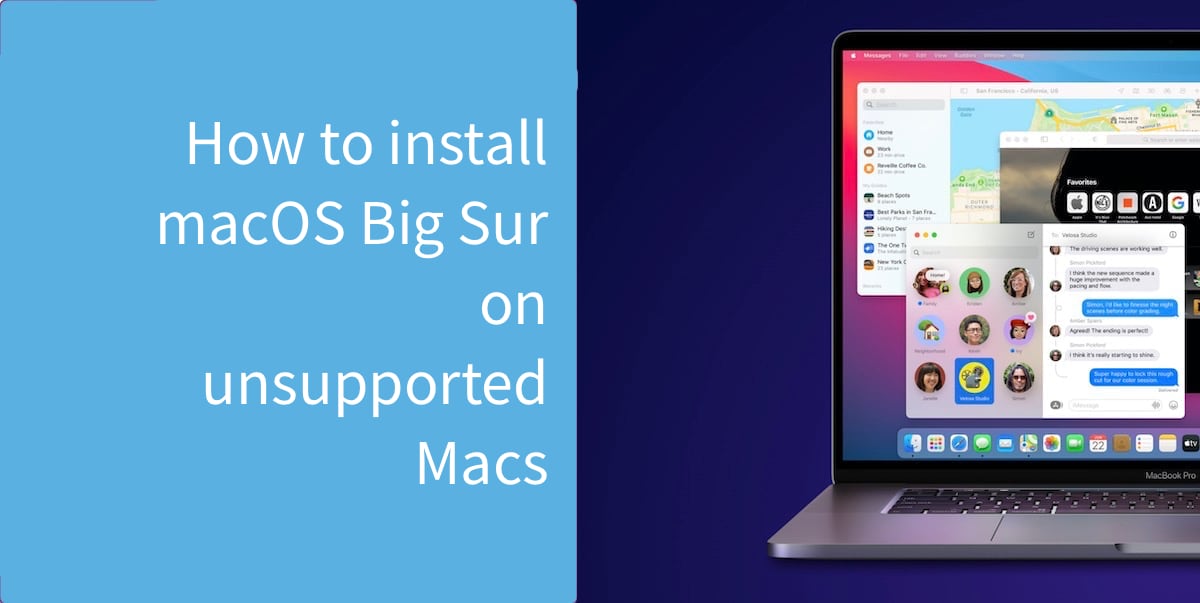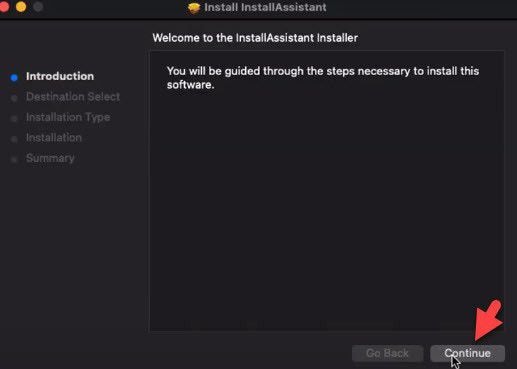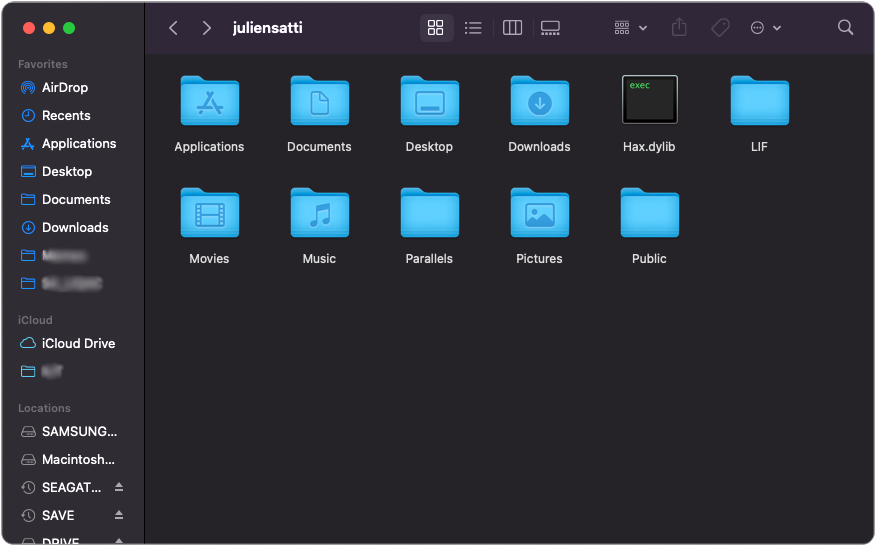In this video, I am going to show you how to install the latest version of macOS Big Sur (11.2) on an Unsupported Mac (2010-2013)Link to the patcher (Shout-o. Sadly, these Macs are way too old to even boot Big Sur, so they do not support this patcher. Note: 2008 Mac Pros do work with Big Sur, but not with this patcher. I recommend checking out StarPlayrX's BigMac Patcher for those. Dec 10, 2020 How to install Big Sur on an unsupported Mac If your Mac is more than a few years old and you try to install Big Sur on it you will hit a few hurdles - the first being the fact that Software Update. MacBook Pro (13-inch, M1, 2020) MacBook Pro (13-inch, 2020, Two Thunderbolt 3 ports) MacBook Pro (13-inch, 2020, Four Thunderbolt 3 ports) MacBook Pro (16-inch, 2019). Patched Sur is a UI patcher for macOS Big Sur, designed to make it easy to run macOS 11 on unsupported Macs. This patcher hopes to allow any user of any knowledge to patch their Mac, while still giving you freedom on how you want to use your Mac.
We all know by now that macOS Big Sur is the latest and greatest version of Apple’s Mac operating system. It was released in November 2020 and offered some serious advancements, especially on the visual side. If you have an older machine, though, you may be wondering whether your Mac is compatible. Let’s shed some light on macOS Big Sur system requirements and help you check whether your Mac supports the new OS.
Before you attempt to upgrade to Big Sur
There are a couple of things you should do before you upgrade to Big Sur.
- Back up your Mac.
It doesn’t matter whether you use Time Machine or a third-party backup tool, just make sure you backup your Mac immediately before you upgrade.
- Free up some space for the new OS
To get macOS Big Sur running on your Mac, you need at least 20GB of free space. So, if you aren’t sure you have enough, here’s how to check it. Click the Apple menu and select About This Mac. Go to the Storage tab to let your Mac calculate the amount of free space. If you don’t have enough, you can try removing some old junk with CleanMyMac X. This app detects ancient cache, user log files, and other clutter and helps you delete it from your Mac.
- Download the free version of CleanMyMac X and install it, then launch.
- Press Scan.
- Click Run.
That’s all there is to it. I managed to clear 10GB in just a couple of minutes, which saved me hours I would have spent if I were to do it manually.
macOS Big Sur requirements
Here’s the list of macOS Big Sur supported Macs:
- Any Mac Pro or iMac Pro
- MacBook Pro and MacBook Air 2013 and later
- iMac and Mac mini 2014 and later
- MacBook 2015 and later
As you can see, some Macs released as long ago as 2013 can officially run Big Sur. That’s pretty good considering the number of macOS updates there have been since then and the new features they have introduced.
Sadly, a few machines that were supported to upgrade to Catalina have fallen off the list for Big Sur, notably the 2012 MacBook Pro, MacBook Air, and iMac.
Mac models that do crash
Immediately after Big Sur's release on November 13, 2020, Mac users started reporting system failures that appeared to affect MacBooks from 2013-2014. The attempted installation resulted in 'bricking some older MacBook Pro models,' according to MacRumors. Notably, those MacBooks are the oldest still supported Macs that can run Big Sur. So if your MacBook belongs to that generation, we advice you to do little research on this before you rush to install Big Sur.
macOS Big Sur compatibility
If your Mac’s model is on the list of “officially supported” Macs to run Big Sur, you will definitely be able to upgrade it to the latest OS. You can be sure the installer will run on your Mac and that if you run into trouble, you can expect help from Apple, either in the form of support documentation or an update to the OS.
But, if your Mac is slightly older and isn’t on the list, there is a possibility you can still update it to Big Sur. Several Mac users have had some success installing the Big Sur beta on Macs that aren’t on Apple’s list. It requires a workaround, and there’s no guarantee that it will continue to work when the final version of Big Sur is released or when updates are issued. But, if you’re determined to install Big Sur on an older Mac, or you want to try it as a fun project, it’s an option.
Things to consider before you try to install Big Sur on an unsupported Mac
Installing macOS Big Sur on a Mac that’s not on Apple’s official list of unsupported Macs isn’t as straightforward as just downloading the installer and running it. How you install it will depend on the Mac you’re trying to install it on, and we’ll come to that later in the article. But there are other things you need to consider.
- Your Mac may not run at all afterwards.
If you get the installation process wrong or something just doesn’t work as it should, you could be left with a Mac that doesn’t boot. For that reason, you should make a bootable clone of your startup drive before you start.
Macos 11 Big Sur On Unsupported Macs Os
- Even if your Mac boots, parts of it won’t work
Among those users who successfully installed the beta version of Big Sur on unsupported Macs, most reported that either the graphics system (GPU) didn’t work or that Wi-Fi didn’t work. You can get around the wifi issue by replacing the internal Wi-Fi card or using a USB Wi-Fi adaptor, but you can’t replace the GPU.
- There’s no guarantee updates will work
Just as you can’t use the regular installer to install Big Sur on an unsupported Mac, you won’t be able to install updates using Software Update. That could leave you vulnerable to security flaws.
How to upgrade to Big Sur on an unsupported Mac
As we said earlier, the specifics of how you install Big Sur on an older Mac vary according to the Mac, but there are lots of success stories in this thread.
One example is the user who installed the Big Sur beta on a 2012 15in MacBook Pro, and it ran well apart from Wi-Fi not working. That user got around the problem by using an iPhone as a hotspot (you can use Personal Hotspot by connecting to an iPhone via Bluetooth or USB). Another user reported installing Big Sur on a 2012 Mac mini, but with sound and Wi-Fi not working.
The question of whether or not your Mac is compatible with macOS Big Sur can’t be answered just by looking at Apple’s list of supported Macs. Those are the machines on which Apple has decided to support installation, but there are others on which Big Sur will run, albeit with a bit of extra work. You should decide for yourself whether you want to take risks associated with installing Big Sur on an unsupported Mac. And, if you decide to go ahead, be sure to back up your Mac and clean it up using Mac maintenance software like CleanMyMac X.
macOS 11 Big Sur is an advanced Macintosh operating system that you can install on your Mac. It has got tons of new features to enhance the user experience, like making safari browser 50% faster, new features of messages, Air Pods improvements, new-design sidebar in mail and photos, widgets in the notification bar, and many more.
Apple announced this new software on 22 June at WWDC. And this time, Apple did a big challenge and released the macOS 11 Big Sur along with iOS 14, iPadOS 14, tvOS 14, and watchOS 7. Meanwhile, Apple highlighted all the new features, changes, and improvements to the current software. You can download this new operating system from various sources now. Unfortunately, some Macs can't receive macOS 11 Big Sur update and they can't install the new operating system. In this article, we will discuss how to install macOS 11 Big Sur on an Unsupported Mac with easy steps.
Part 1: Official List of Big Sur Supported Mac Models
macOS 11 Big Sur Developer Beta is available to download. But you have to check your Mac compatibility first. If you have the below-listed Macs then you don't have to install macOS 11 Big Sur as these models will receive an update for macOS Big Sur automatically.
- MacBook 2015 and later
- MacBook Air and Pro Late 2013 and later
- Mac mini 2014 and later
- iMac 2014 and later
- iMac Pro 2017 and later (all models)
- Mac Pro 2013 and later

Part 2: Unsupported Mac Models of Big Sur (Not Eligible for Direct Upgrade)
On the other hand, if you have the below-listed Mac computers then you can install macOS Big Sur on those models as they are unsupported officially. You have to do some hacks to let Big Sur running on unsupported Macs.
- MacBook Air 2012
- MacBook Pro 2012 and Early 2013 MacBook Pro
- 2012 Mac Mini
- 2012 and 2013 iMac
Part 3: How to Install macOS Big Sur on an Unsupported Mac
Before the installation, make sure that you take a backup of your Mac on an external hard disk as you will lose all your data when you install the new operating system. There are several backup software like Time Machine, iCloud, Dropbox, and many more. Once you have taken a backup follow the instructions below to install macOS Big Sur on your unsupported Mac.

Step 1: First you need to download two files from the links below to complete the macOS 11 Big Sur installation on your unsupported Mac.

- macOS Big Sur PKG installer: https://developer.apple.com/macos/
- macOS Big Sur PKG install hack: https://forums.macrumors.com/simple-installer-hack-zip.926156/
Step 2: After you have downloaded these two files, unzip the hack and copy the hax.dylib file and then paste it to home folder.
Step 3: Click on Install Assistant.pkg to install required contents to your Mac. Make sure that you have enough space on your hard disk as the file will take 20.1 MB size on your computer.
Step 4: Now go ahead and tap on the Install button to install the software on the disk 'Macintosh SSD'. Once you click the 'Install' button then it will ask you to enter your password. Next, click the 'Install Software' button.
Step 5: Next, you have to boot your computer into Recovery mode. You can do that by pressing Command + R immediately on startup until Recovery option appears. In case if you have no recovery partition, you can press down Command + Option +R to get into Internet Recovery. After that, go to Utilities -> Terminal and type 'csrutil disable', followed by pressing the Enter button on your keyboard.
Step 6: Type the following two commands in the terminal. Once you apply the first command, type your login password, and then input the second command.
sudo defaults write /Library/Preferences/com.apple.security.libraryvalidation.plist DisableLibraryValidation -bool true
launchctl setenv DYLD_INSERT_LIBRARIES $PWD/Hax.dylib

Step 7: Next, run the macOS 11 Big Sur installer app that you installed from InstallAssistant.pkg a while ago. Now click on the 'Continue' button and follow the instructions to complete the installation process.
Step 8: The installation will take about 30 minutes approximately. Once the installation is successful you will see the macOS 11 Big Sur wallpaper on your Mac screen. That's it, you have installed macOS Big Sur on your unsupported Mac successfully.
Patched Sur Download
Follow the above-mentioned method to install macOS 11 Big Sur on unsupported Mac devices. The method is quite easy; you just have to focus on the command line and other installation procedures.
Part 4: Alternative Method to Install Big Sur on an Unsupported Mac
The above tutorial is for users who still have access to their device. However, if your Mac is unable to boot into Desktop or you are using a Hackintosh, then you should follow the alternative method instead. In this part, we will show you how to create a macOS Big Sugr bootable USB on a Windows PC and install macOS Big Sur on unsupported Mac by using that bootable media.
Step 1: Make a full backup of important files on your Mac.
Step 2: Download a copy of UUByte DMG Editor and follow the instructions to install it on your Windows PC.
Step 3: Insert a USB flash drive into PC and open UUByte DMG Editor. Now, click the Burn tab to get into the new window.
Step 4: You will see three options on Burn windows. Please import macOS Big Sur DMG file into the program and choose the USB drive name. You can also set a new name for that USB drive. And this is optional.
Step 5: Once the setting process is completed, just click 'Burn' button located at the bottom to start burning dmg file to USB on your PC. You should wait about 10 minutes for this task.
Step 6: Plug Big Sur bootable USB on your Mac and press Power + Option combine keys to open Startup Manager. At this stage, you are able to select a booting device. Click on the USB drive and start Big Sur installation process.
This part is mainly for Windows users who want to install Big Sur on an unsupported Mac. The most important step is to create a bootable USB drive.
Troubleshooting:

If your system is showing any error message while installing the macOS Big Sur you can try these methods to fix it.
Big Sur For Unsupported Macs
- Restart your Computer and continue with the installation.
- Make sure that your Mac’s date and time is correct.
- Check your Hard Drive to see that you have enough free space to carry out the installation.
- Make sure that the version of macOS Big Sur is up to date including the macOs installer
- Run first aid on your startup disk before installing macOS Big Sur to check any system files are damaged or not.
Summary
You can see that it is not hard to install macOS Big Sur on an Supported Mac. Make sure that you key in the right command lines which are mentioned above, as typing a wrong command can harm your system. Enjoy the great features that come with the macOS Big Sur on your unsupported device!